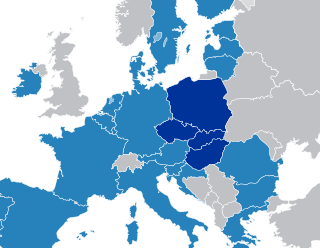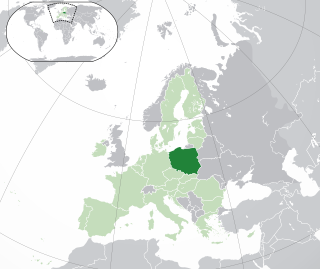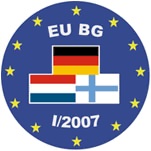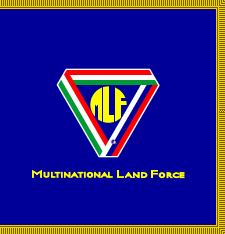
Belarus, officially the Republic of Belarus, is a landlocked country in Eastern Europe. It is bordered by Russia to the east and northeast, Ukraine to the south, Poland to the west, and Lithuania and Latvia to the northwest. Covering an area of 207,600 square kilometres (80,200 sq mi) and with a population of 9.2 million, Belarus is the 13th-largest and the 20th-most populous country in Europe. The country has a hemiboreal climate and is administratively divided into six regions. Minsk is the capital and largest city; it is administered separately as a city with special status.

Poland, officially the Republic of Poland, is a country in Central Europe. It is divided into 16 administrative provinces called voivodeships, covering an area of 313,931 km2 (121,209 sq mi). Poland has a population of over 38 million and is the fifth-most populous member state of the European Union. Warsaw is the nation's capital and largest metropolis. Other major cities include Kraków, Gdańsk, Wrocław, Katowice, Łódź, Poznań, Szczecin and Lublin.
The Republic of Poland is a Central European country and member of the European Union and NATO, among others. Poland wields considerable influence in Central and Eastern Europe and is a middle power in international affairs. The foreign policy of Poland is based on four basic commitments: to Atlantic co-operation, to European integration, to international development and to international law.

The Visegrád Group is a cultural and political alliance of four Central European countries: the Czech Republic, Hungary, Poland, and Slovakia. The alliance aims to advance co-operation in military, economic, cultural and energy affairs, and to further their integration with the EU. All four states are also members of the European Union (EU), the North Atlantic Treaty Organization (NATO), and the Bucharest Nine (B9).

Polish people, or Poles, are a West Slavic ethnic group and nation who share a common history, culture, the Polish language and are identified with the country of Poland in Central Europe. The preamble to the Constitution of the Republic of Poland defines the Polish nation as comprising all the citizens of Poland, regardless of heritage or ethnicity. The majority of Poles adhere to Roman Catholicism.

Law and Justice is a right-wing populist and national-conservative political party in Poland. Its chairman is Jarosław Kaczyński. It is the dominant party in Poland.

The League of Polish Families is a social conservative political party in Poland, with many far-right elements in the past. The party's original ideology was that of the National Democracy movement which was headed by Roman Dmowski, however in 2006 its leader Roman Giertych distanced himself from that heritage.

An EU Battlegroup is a military unit adhering to the Common Security and Defence Policy (CSDP) of the European Union (EU). Often based on contributions from a coalition of member states, each of the eighteen Battlegroups consists of a battalion-sized force reinforced with combat support elements. Two of the battlegroups were declared to be capable of being assembled for operational deployment at any one time.

Lesbian, gay, bisexual, and transgender (LGBT) people in Poland face legal challenges not faced by non-LGBT residents. According to ILGA-Europe's 2023 report, the status of LGBTQ rights in Poland is the worst among the European Union countries.

The Spanish–Italian Amphibious Battlegroup is one of 18 European Union battlegroups. It is formed by the Spanish–Italian Landing Force (SILF) of the Spanish–Italian Amphibious Force. It consists of 1500 Marines with manpower contributed from the participating countries. From January until June 2009, it was on the EU Battlegroup standby roster.

The Balkan Battlegroup is an EU Battlegroup led by Greece. Originally referred to as HELBROC, it consists of military units from Greece, Bulgaria, Romania, Cyprus, Ukraine, and Serbia. During its third and fourth standby period in the second half of 2011 and 2014, the Balkan Battlegroup was joined by Ukraine, while Serbia signed its participation in 2016.

Battlegroup 107 or BG-107 is an EU Battlegroup. It originally consisted of military elements from the Netherlands, Germany, and Finland. From 1 January 2007 until 30 June 2007, it was on standby under German leadership. In preparation for its second standby period in the first half of 2011, when it was also known as EUBG 2011/1, its composition changed; Austrian and Lithuanian troops were added, the Netherlands took over command.

The Czech–Slovak Battlegroup also, incorrectly, called the Czech–Slovak Battle Group is an EU Battlegroup, led by the Czech Republic, in which Slovakia also participates.

Polish-Serbian relations are foreign relations between Poland and Serbia. Diplomatic relations have been maintained since Poland and the Kingdom of Serbs, Croats and Slovenes established them in 1919.
The British Battlegroup or UK Battlegroup is an EU Battlegroup, consisting entirely of British armed forces. It was on standby from 1 January, until 30 June 2005, and from 1 July, until 31 December 2008.
The Visegrád Battlegroup or V4 EU Battlegroup is an EU Battlegroup led by Poland, in which the other fellow Visegrád Group countries – the Czech Republic, Slovakia and Hungary participate. It was on standby from 1 January until 30 June 2016 and from 1 July until 31 December 2019. It is scheduled to go on standby in the first half of 2023.
The UK–Dutch Battlegroup or UK/NL EUBG 2010 is an EU Battlegroup led by the United Kingdom, in which the Netherlands also participate. It was on standby during the first half of 2010, simultaneously with Battlegroup I-2010.

The Weimar Battlegroup is a multinational EU Battlegroup under Polish leadership, in which Germany and France also participate as members of the Weimar Triangle. It was on standby in the first half of 2013.

The Multinational Land Force (MLF), also known as the Italian–Hungarian–Slovenian Battlegroup was an EU Battlegroup led by Italy, in which Hungary and Slovenia also participate.

This article outlines the defence forces of the European Union (EU), which implement the EU's Common Security and Defence Policy (CSDP) in CSDP missions. There are two categories of EU multinational forces: ones that have been established intergovernmentally and made available to the CSDP through article 42.3 of the Treaty on European Union (TEU), such as the Eurocorps; and the EU Battlegroups, established at the EU level.















